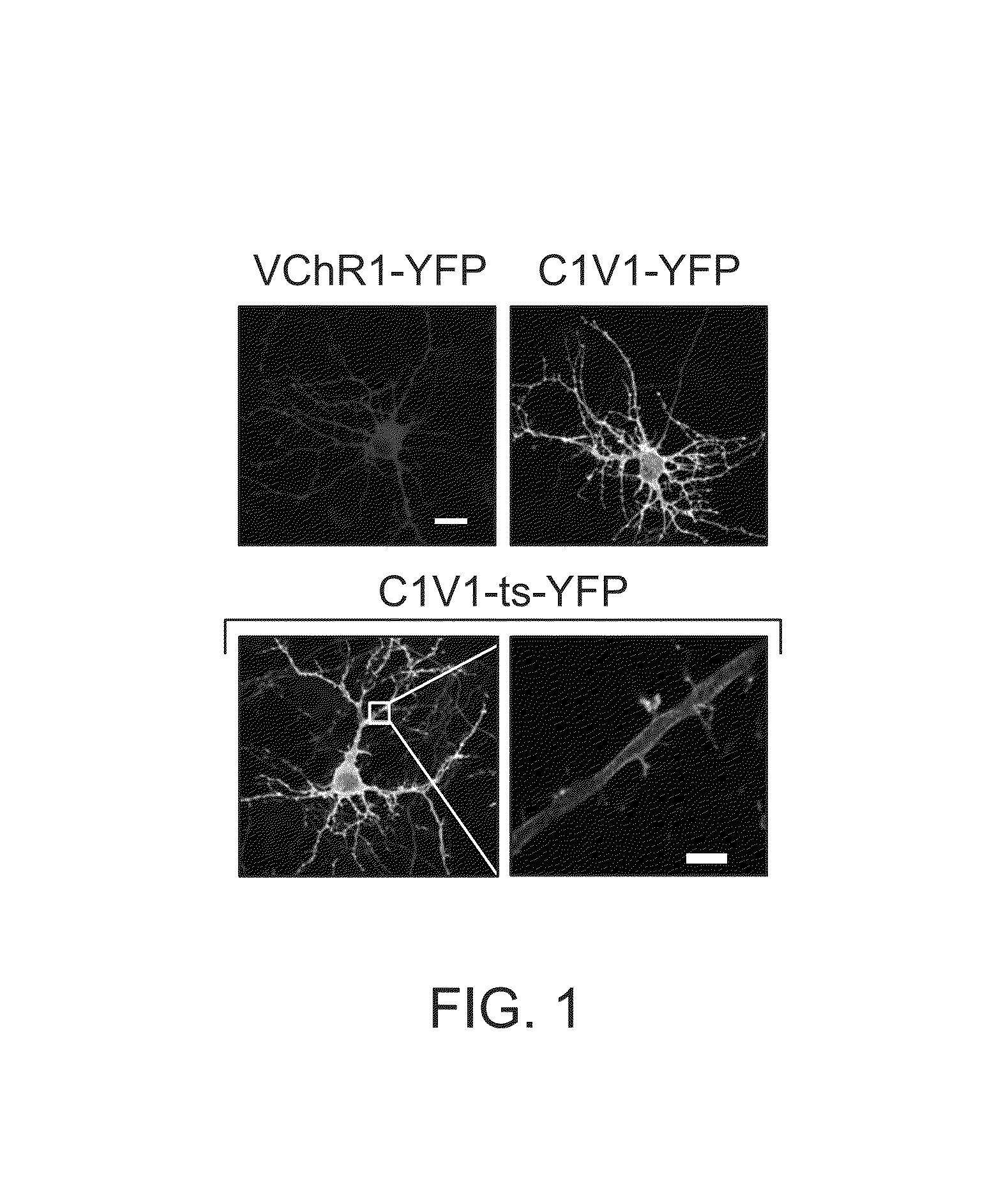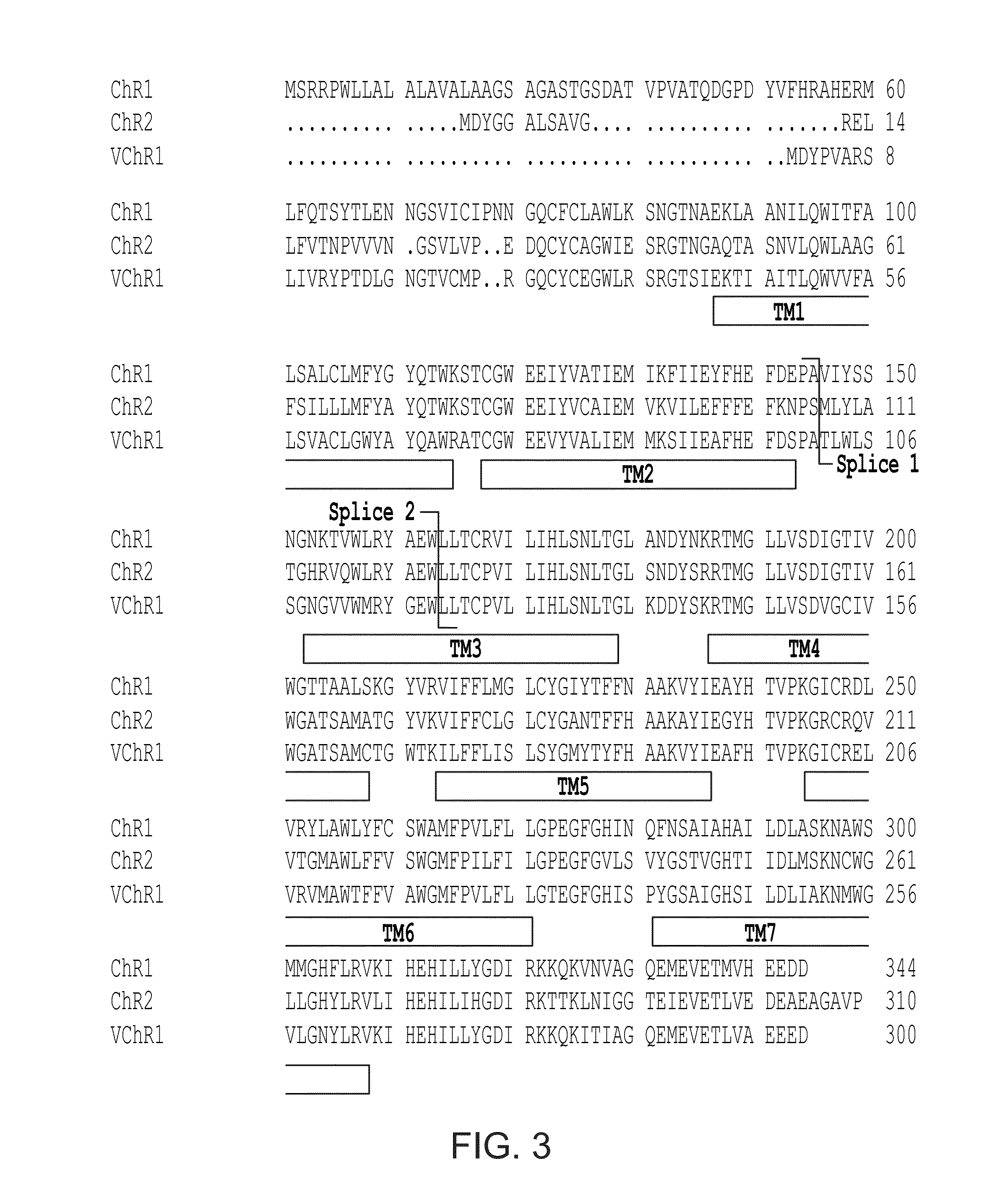Light-activated chimeric opsins and methods of using the same
a technology of chimeric opsins and light-activated chimeric opsins, which is applied in the field of light-activated chimeric opsins and methods of using the same, and can solve the problems of not being clear whether such an imbalance exists, hypotheses that are by no means universally accepted, and pharmacological and electrical interventions lacking the necessary specificity
- Summary
- Abstract
- Description
- Claims
- Application Information
AI Technical Summary
Benefits of technology
Problems solved by technology
Method used
Image
Examples
example 1
Development of Chimeric Channelrhodopsin Variant C1V1
[0136]In this example, a tool that would permit the driving of cortical E / I elevations and the monitoring of gamma oscillations in cortical slices, as well as in vivo in live animal experiments, was sought, with three key properties: 1) much higher potency to enable dose-response investigation; 2) low desensitization to allow for step-like changes in E / I balance; and 3) redshifted excitation to allow comparative drive of different populations within the same preparation.
[0137]These experiments were initially attempted with VChR1, which displays both a redshift and reduced desensitization14, but previous investigation suggested that photocurrents in cells expressing VChR1 were small (−100−150 pA14), and did not elicit robust synaptic activity in downstream cells (not shown). Indeed, when first attempting to express VChR1 in cells, only small photocurrents were observed, (FIG. 1) consistent with previous findings. Adding a membrane ...
example 2
Optimization of Photocurrent Kinetics of C1V1
[0143]Fast deactivation properties28 of this redshifted opsin would be required for maximal temporal as well as spectral separation from other opsins that are activated by wavelengths located towards the blue end of the visible spectrum. However, it was found that the photocurrents displayed by C1V1-ts-EYFP exhibited >10-fold slower decay than ChR2, and even slower decay than the original VChR1 (FIG. 9; Toff 156±12 ms and 132±12 ms for C1V1-ts-EYFP (n=4) and VChR1-EYFP (n=5), respectively; Table 1), potentially precluding the use of C1V1 for applications requiring rapid firing rates. To correct the photocurrent kinetics of C1V1, the chromophore region was searched using known structural models22,28 (FIG. 8) for mutations with faster photocycle kinetics, reduced inactivation and reduced blue absorption. Next, glutamate-122 was mutated to threonine, based on studies of the glutamate-rich motif in helix 2 showing that this mutation reduces i...
example 3
Use of Novel C1V1 Chimeras in Prefrontal Cortex Neurons
[0151]To test these novel C1V1 opsin genes in neurons, lentiviral vectors encoding C1V1-ts-EYFP and the point mutation combinations above were generated. These opsins were then expressed in cultured hippocampal neurons and recorded whole-cell photocurrents under identical stimulation conditions (2 ms pulses, 542 nm light, 5.5 mW mm−2) to determine whether the improvement in photocurrent amplitude resulted directly from the increased expression of C1V1 compared to VChR1.
[0152]Materials and Methods
[0153]Animals
[0154]Wild-type or transgenic Parvalbumin::Cre C57 / BL6J male mice were group housed three to five to a cage and kept on a reverse 12 hour light / dark cycle with ad libitum food and water. Experimental protocols were approved by Stanford University IACUC and meet guidelines of the National Institutes of Health guide for the Care and Use of Laboratory Animals.
[0155]Whole Cell Patch-Clamp Electrophysiology in Hippocampal and Cor...
PUM
| Property | Measurement | Unit |
|---|---|---|
| wavelength | aaaaa | aaaaa |
| voltage clamp | aaaaa | aaaaa |
| wavelength | aaaaa | aaaaa |
Abstract
Description
Claims
Application Information
 Login to View More
Login to View More - R&D
- Intellectual Property
- Life Sciences
- Materials
- Tech Scout
- Unparalleled Data Quality
- Higher Quality Content
- 60% Fewer Hallucinations
Browse by: Latest US Patents, China's latest patents, Technical Efficacy Thesaurus, Application Domain, Technology Topic, Popular Technical Reports.
© 2025 PatSnap. All rights reserved.Legal|Privacy policy|Modern Slavery Act Transparency Statement|Sitemap|About US| Contact US: help@patsnap.com



